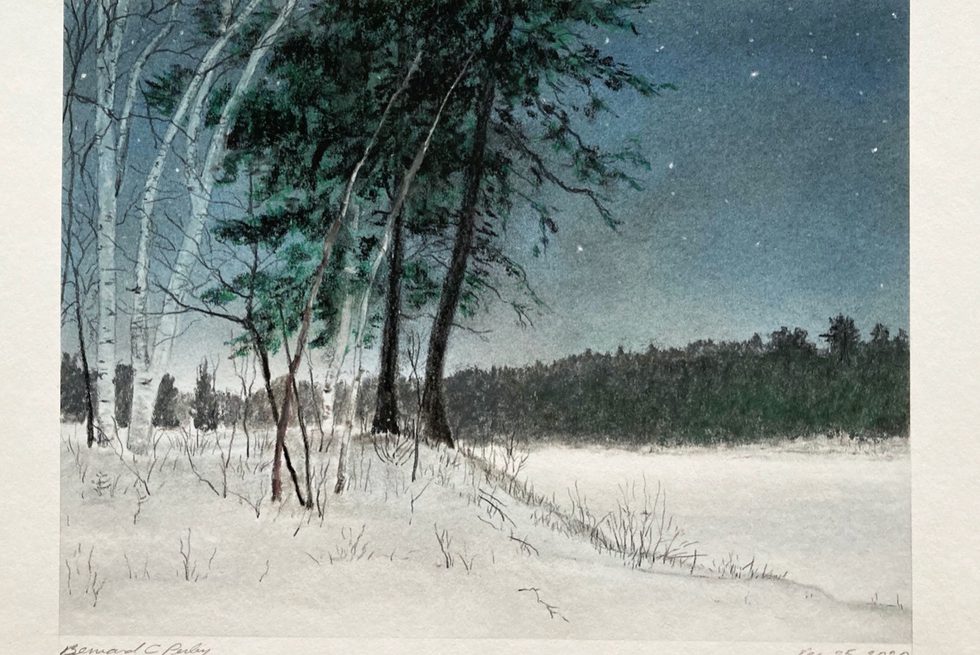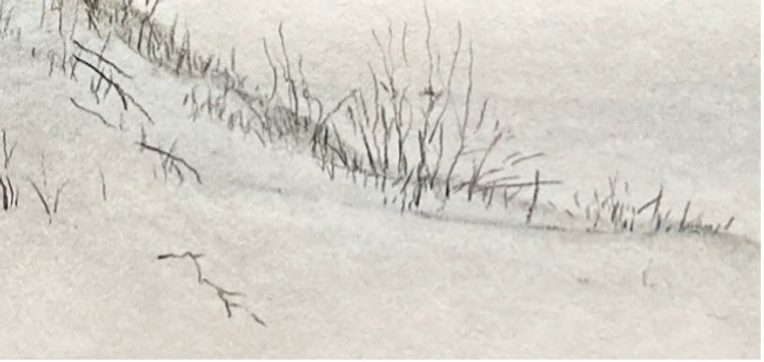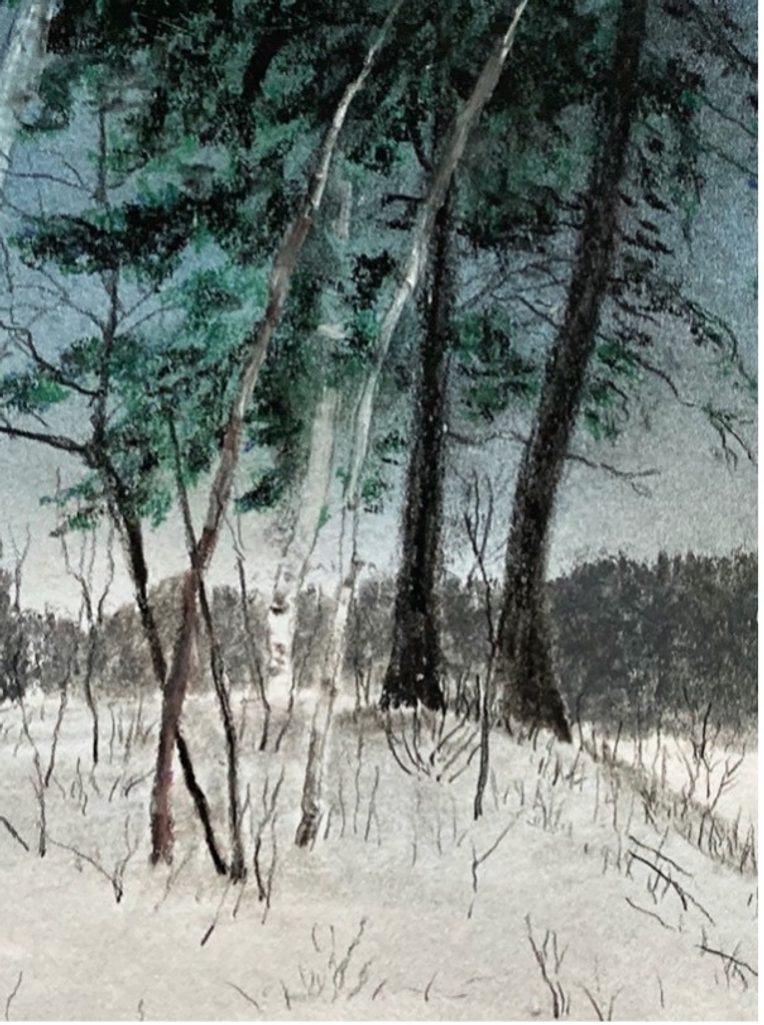Illumination: Ethnographic Arts in Times of Darkness
From the Series: Art and Ethnographic Forms in Dark Times
From the Series: Art and Ethnographic Forms in Dark Times

2020. What a year! A year when a myriad of threats darkened the world and foreclosed possibilities. Winter’s decreasing hours of daylight made tangible the darkened world.
December 25, 2020. I am stuck in Vancouver, on the other side of the continent, far away from my ancestral homeland, Wabanakew, the land of the dawn (its colonial name is New Brunswick, Canada). The rain of the northwest coast temperate rain forest patters quietly on the roof. I sit at my drafting table staring at a blank sheet of paper and imagine being back home. The dark days of winter seem darker in Vancouver. There is no snow to lighten the days or to gently illuminate the winter nights. My mournful mood is exacerbated by the travel prohibition and the forced social distancing necessitated by the lurking existential threat of COVID-19. Where do I find light in these dark days?
I look to my memories of Wabanakew. It is time to illuminate my mournful mood by practicing my ethnographic arts. I peer into the surface of the paper, creating a Maliseet world through language, experience, and place. Conjuring the numinous in sequences of ritual materiality, the world coalesces in memory and becomes animated through inscription of colors and lines onto the paper. Like all creation stories, it must have a beginning. This emergent Maliseet cosmogony begins with darkness.
I scratch blacks, dark blues, a hint of greys and streaks of white with frenetic gestures and a tumult of marks.

“Incipit liber revelationis . . . ” (Here begins the book of revelation) (De Hamel 2017, 205). In tenth-century Spain, the monk, Beatus of Liébanan, assembled a collection of illuminated manuscripts that interpreted the Apocalypse, the Book of Revelations. Spain was witnessing a changing world during a time of great upheaval; “The old Roman Hispanic civilization was visibly in ruins. Muslim Berbers from North Africa had surged upwards across the Strait of Gibraltar in 711. The Islamic Umayyad emirate was established in Córdoba in 756” (De Hamel 2017, 191). Furthermore, some calculations foretold the “end of days” in the eighth century. These convergent events prompted scribes to create illuminated manuscripts that reinforced the idea that “the destruction foretold in the Apocalypse must have seemed terrifyingly current” (De Hamel 2017, 191).
The collected illuminated manuscripts were assembled by Beatus and the resultant manuscript included his commentaries. The world continued after the eighth century, but new calculations predicted the end of days in the tenth century. The Beatus manuscripts received renewed popularity and multiple copies were produced to “make people fear the end of the world” (De Hamel 2017, 228). The original Beatus manuscript is lost but subsequent “faithful” copies of those assembled texts are valuable for providing us with insights into how ambient fears in days of darkness and doom were interpreted, illuminated, and made concrete in eighth and tenth century Spain. How will we illuminate our own period of darkness and record our fear of the “end of days”? How will we transform and translate the numinous into the luminous?
The dark cannot last.
First one, two, seven, a hundred, a thousand;
Finally, a multitude of stars
illuminate the sky with celestial light;
Calming the frenzy and agitation of darkness.

Every dark age has observers ready to inscribe hope, in the moment and into the future. The resultant manuscripts—both historical and contemporary—illuminate our human capacity to conceptualize, materialize, and entextualize radical hope in the face of “ontological vulnerability” (Lear 2006, 50). Ethnography in the time of COVID-19 is one such moment. Today, some ethnographers are working alongside community members to co-author, co-illuminate, and co-script better days by observing endurance in this time of darkness. The tools we use are real-time witnessing (social media) as well as documentation (entextualization into more permanent forms [texts, artwork, recordings of performance/demonstration]). The collected ethnographic arts materialized in this series are some illuminations during this moment of darkness.
I am missing the snow in rainy Vancouver.

I need to make it snow on this Christmas day!
The COVID-19-related loss of Indigenous elders in communities is a devastating tragedy (Archambault 2021), a tragedy compounded in communities whose languages are severely endangered. The news reports coming from Indian country are heartbreaking. The loss of knowledge holders is leaving many communities in mourning at the death of their elders, their languages and the wisdom the elders carried on behalf of their communities. These current tragedies in these dark times require the resilience of centuries of survival in the face of the dark forces that accompanied colonialism (Baldwin, Noodin, and Perley 2018; Perley 2020).
Now I need to inscribe with chalk, pencils, and pastels the silent sentinels that watch over the snow-covered landscape.

This dark age requires new illuminators using new tools to imagine futures we have yet to comprehend. Ethnographic arts can be one of those tools. We need new tools for a cosmogony that creates a new world. Lear (2006, 115) describes the stance of “radical hope” in which Chief Plenty Coups of the Crow Nation “enabled them to go forward hopefully into a future that they would be able to grasp only retrospectively, when they could reemerge with concepts with which to understand themselves and their experience.” This lesson is for all of us in these dark days, “we could presumably come to see how radical hope can be not just psychologically advantageous but a legitimate response even to a world catastrophe” (Lear 2006, 115)

The drawing is starting to look like home. Something is missing. It cannot be home without including the river and the opposite riverbank and the hills rising away from the river.
Wolastok. The peaceful river is frozen over with a fresh snowfall, serene in the quiet of midnight, Christmas Eve. It all comes together—Maliseet language and Maliseet landscape, the world of the spiritual and the sacred, the darkness and the light—hope materialized into a luminescent world.

Archambault, Jodi. 2021. “How Covid-19 Threatens Native Languages.” New York Times, January 24.
Baldwin, Daryl, Margaret A. Noodin, and Bernard C. Perley. 2018. “Surviving the Sixth Extinction: American Indian Strategies for Life in the New World.” In After Extinction, edited by Richard Grusin, 201–33. Minneapolis: University of Minnesota Press.
De Hamel, Christopher. 2017. Meetings with Remarkable Manuscripts: Twelve Journeys into the Medieval World. New York: Penguin Press.
Lear, Jonathan. 2006. Radical Hope: Ethics in the Face of Cultural Devastation. Cambridge, Mass.: Harvard University Press.
Perley, Bernard C. 2020. “Indigenous Translocality: Emergent Cosmogonies in the New World Order.” In Theory and Event 23, no. 4: 977–1003.